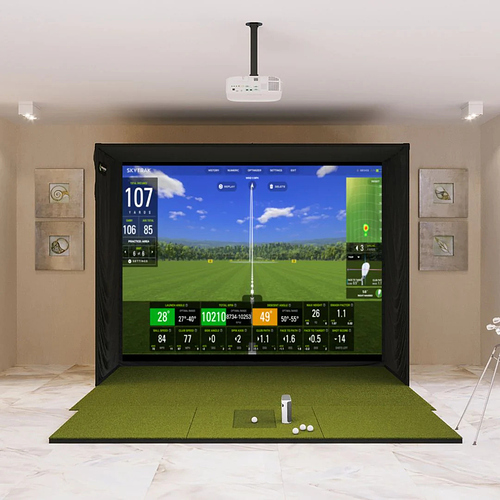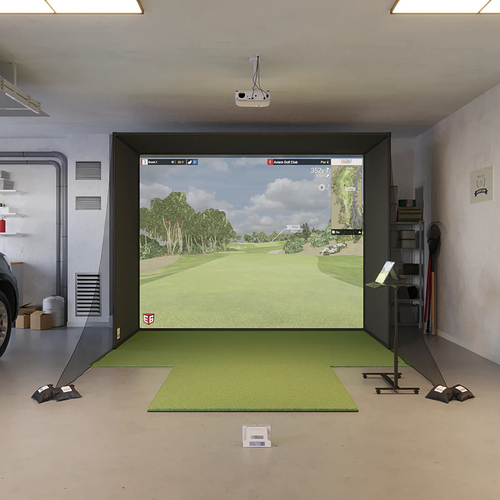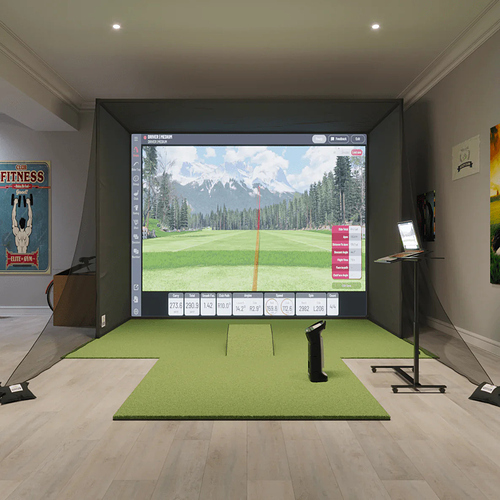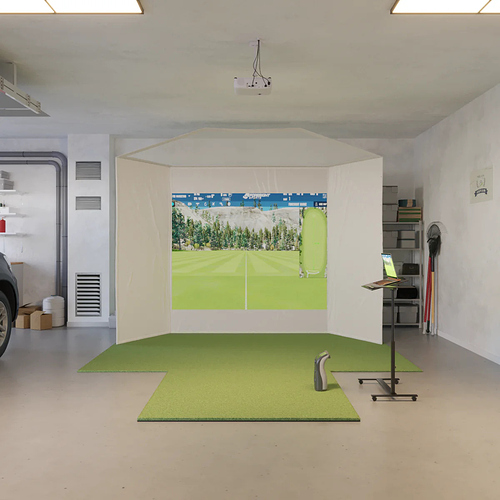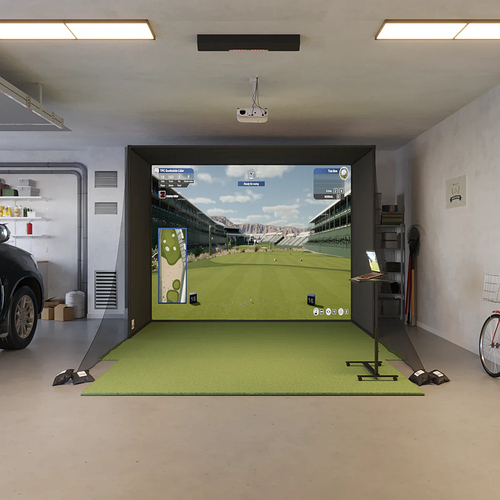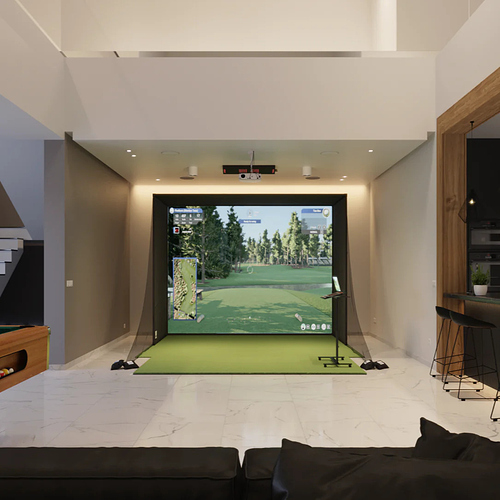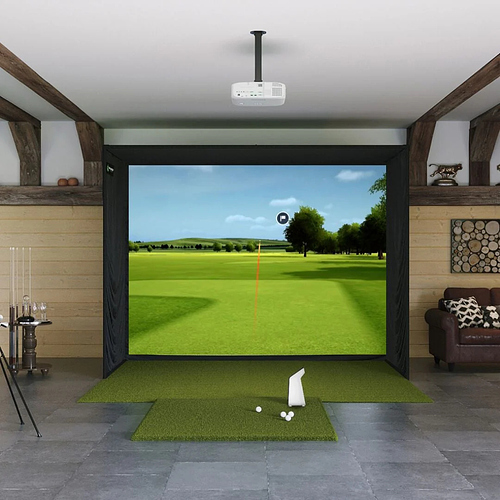Buying a golf simulator for home sounds simple until you realize how many options exist, and how many of them are made for massive spaces most people don’t have. I was in the same boat—trying to find something accurate, reliable, and actually usable in a real house setup, not just a showroom.
No matter if you’re setting up in the garage, basement, or spare bedroom, these are the best golf simulators for home use in 2025. I looked at space, software, data accuracy, and how easy they are to live with.
You found the right guide. Here’s what actually works.
1. SkyTrak+ SIG10 Golf Simulator
This golf simulator is about as balanced as it gets. You’re getting a photometric and radar-based system that reads both ball and club data with solid accuracy. It’s great for tight setups but still gives you enough space to swing freely, especially with the SIG10 enclosure’s clean footprint.
It works with GSPro, E6 Connect, and even the SkyTrak+ app itself gives you plenty of game modes and practice tools. The software experience feels polished, and the data feedback is consistent whether you’re hitting wedges or driver.
If you want a serious sim without maxing out your room dimensions or your budget, this one delivers.
2. FlightScope Mevo+ SwingBay Golf Simulator Package
Some would say this is a good hybrid pick. I would agree. The FlightScope Mevo+ is a radar-based launch monitor, so it needs a little more room behind the ball, but the SwingBay setup keeps the total footprint compact enough for garages and flex spaces.
It shines when you take it outside too. If you’re someone who wants to practice on the range during the day and play virtual rounds at home later, this setup makes that easy.
The Pro Package unlocks full club data and paired with GSPro or E6 Connect, the simulator feels responsive and fully featured. Ideal if you need flexibility in how and where you practice.
3. Uneekor EYE MINI SwingBay Golf Simulator
If you’re short on space but still want high-speed camera tracking, EYE MINI does the job. It’s a compact launch monitor with built-in screens, solid data output, and Uneekor’s Club Optix video feedback.
It uses ball and club data to give you swing path, impact point, and spin metrics. And it connects with software like GSPro for course play or driving range sessions.
The SwingBay enclosure keeps the setup tight and portable enough to fit into most home environments. This is the one for golfers who want Uneekor’s camera quality without the ceiling-mounted commitment.
4. Foresight Sports GC3 Retractable Golf Simulator
The Foresight Sports GC3 has built a name around accuracy and reliability, and pairing it with a retractable screen means you’re not giving up a whole room forever. This package gives you the performance of a teaching bay and the flexibility to pack it away when needed.
The photometric tracking is spot on. You’re getting launch angle, spin, club path, and more. FSX Play and FSX 2020 give you deep practice tools and plenty of course options.
This setup is for someone who takes their practice seriously but doesn’t have the space to leave a simulator up 24/7.
5. Uneekor QED SwingBay Golf Simulator Package
If you’ve got the ceiling height and want real-time feedback with depth, QED delivers. The dual high-speed camera system tracks ball and club interaction with serious detail. Paired with SwingBay, it fits clean into a mid-sized room setup.
You’re getting access to Ignite, View, Refine+, and integration with third-party software like GSPro. It’s the simulator for someone who loves looking at replays, slow-motion impact, and wants deep analysis between swings.
Not the most portable setup, but one of the most complete if you want pro-style data in a fixed home space.
6. Uneekor EYE XO2 SwingBay Golf Simulator
Six on the list is another Uneekor option. The EYE XO2 takes everything Uneekor does well and dials it up. This one is made for high ceilings, fixed rooms, and golfers who want ceiling-mounted hardware that stays out of the way.
It covers club face, path, attack angle, loft, and even strike location. If you’re someone who plays competitively or coaches others, this is the home setup you want. The SwingBay enclosure helps scale it into a room-sized footprint while still feeling like a professional install.
This isn’t for someone testing the waters. It’s for players who know exactly what they’re looking for in their numbers.
7. Garmin Approach R50 SIG10 Golf Simulator
Lets wrap this up. The R50 is Garmin’s follow-up to the R10, and it’s come a long way. With 43,000+ courses, a 10-inch touchscreen, and strong indoor data tracking, this setup is probably the easiest to get going.
The SIG10 enclosure gives it that full simulator look while keeping the total space required manageable. If you’re tight on budget but still want a home simulator that feels like a real experience, this one checks the boxes.
It doesn’t go as deep with club metrics unless you use stickers, but it gives solid ball data and feels polished enough to hold its own in a home setup.
How To Choose The Best Golf Simulator For Home
Before you drop cash on a simulator, think about your space, goals, and what data you actually want.
- Room size: Most setups need about 10 feet wide by 12 feet long. If you’re swinging a driver indoors, you’ll want at least 9 to 10 feet of ceiling height.
- Launch monitor vs. full simulator: If you already have a net or mat, a launch monitor could be enough. Full simulator packages come with screens, enclosures, and software.
- Accuracy and features: Some give just ball speed and carry. Others dive into path, face angle, attack angle, and more. Match it to your needs.
- Software and compatibility: Want to play Pebble Beach or Augusta? Look for GSPro, E6 Connect, or FSX Play compatibility.
- Portability: If you’re using a shared room or want to take it outside sometimes, choose a monitor like Mevo+ or EYE MINI.
FAQs
What’s the best golf simulator for home use?
The SkyTrak+ SIG10 golf simulator is a top pick for most people. It’s accurate, works in smaller rooms, and supports great software like GSPro.
Can I fit a golf simulator in my garage?
Yes. Many of these setups are designed for garages. Just check ceiling height and make sure you have enough depth for radar systems.
What’s the difference between a launch monitor and a golf simulator?
A launch monitor gives you data. A simulator adds visuals, virtual courses, and immersive practice. You can pair a monitor with software to turn it into a simulator.
What size room do I need for a golf simulator?
At least 10’ W x 12’ L x 9’ H is recommended. More is better, especially if you’re using radar-based units like Mevo+ or KIT.
Which golf simulators work with GSPro?
SkyTrak+, Mevo+, GC3, Uneekor QED, EYE MINI, and EYE XO2 all support GSPro with the right setup.
Final Thoughts: Choose What Fits Your Room and Your Game
Not all home simulators need to be massive or expensive. What matters is picking the one that fits your space, gives you the data you care about, and works with how you like to practice.
SkyTrak+ and GC3 are great balanced picks. Mevo+ and Garmin R50 give you flexibility and portability. Uneekor’s lineup fits the golfers who want full-time, tour-level feedback.
Use your room dimensions, your budget, and your goals to guide your pick. That’s the real difference between just buying a golf simulator and building a setup that helps you actually get better.

